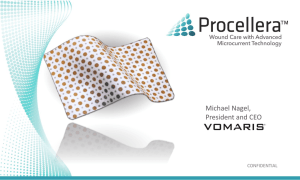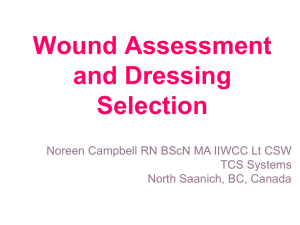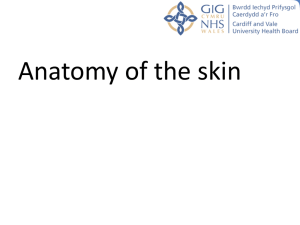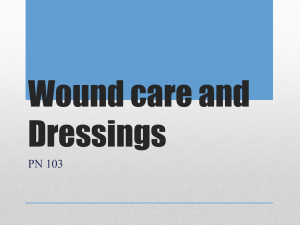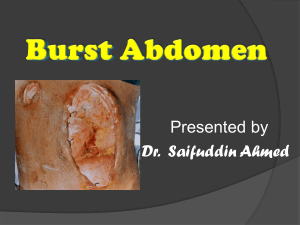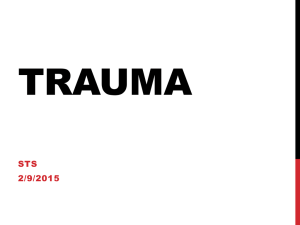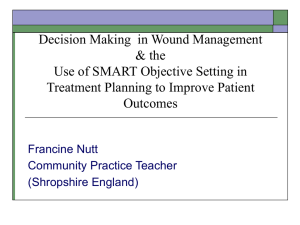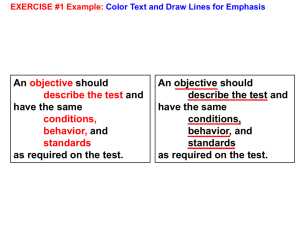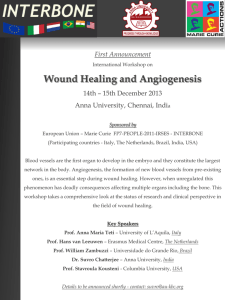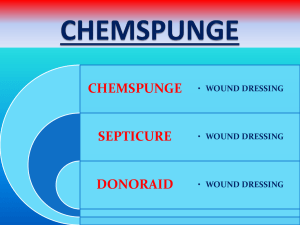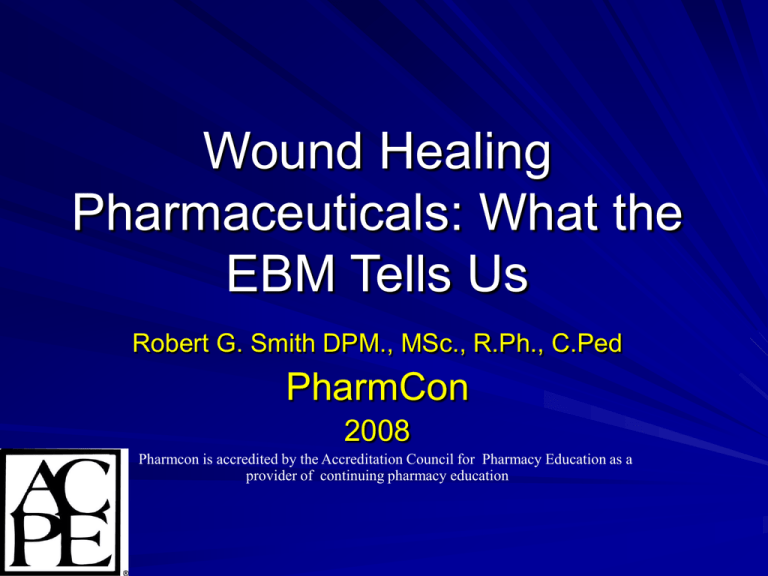
Wound Healing
Pharmaceuticals: What the
EBM Tells Us
Robert G. Smith DPM., MSc., R.Ph., C.Ped
PharmCon
2008
Pharmcon is accredited by the Accreditation Council for Pharmacy Education as a
provider of continuing pharmacy education
Learning Objectives
Appreciate the selection of the most appropriate
wound healing product with regard to a
presenting wound type as supported by relevant
clinical evidence based data.
Develop a wound care product formulary for use
in a clinical practice supported by available
evidence based medicine.
Appreciate the clinical data regarding medicinal
alternative wound care products as found in the
literature
Prevalence of Diabetes Mellitus
Total: 20.8 million
people—7 percent of
the population—have
diabetes.
Diagnosed: 14.6
million people
Undiagnosed: 6.2
million people
Approximately 15% of
patients with diabetes
will have a foot ulcer
and those who
develop an ulcer, 6%
will be hospitalized
due to infection or
other ulcer related
complications
Three Major Problems of an Open
Wound
Hemorrhage
Mechanical Disruption
of Tissues
Infection
Lower Extremity Wounds
Diabetic
Venous
Ischemic
Combination
Wound Types
Acute Wounds: Wounds that heal with an
orderly and timely restoration of anatomic
and functional integrity
Chronic Wounds: Wounds that appear to
be stagnated in the inflammatory or
proliferative phase. Accumulation of
excess extracellular matrix components or
matrix metalloproteinases (collageaseselastase)
Wound Care Product History
Early accounts from 1650 BC described
standard treatments to include grease, honey,
and lint.
The Egyptians and Greeks introduced various
metallic salt compounds, astringents, and
antiseptics.
Joseph Lister addressed wound sepsis leading
to the use of specific chemical therapies to
manage wounds.
Winter’s 1962 observations of the benefits of a
moist wound environment regarding scar
formation
Central Dressing Selection Theme
Selection based on
experience not
scientific knowledge
Studies focused on
dressings as related
to wound type and
cost factors
Morrison 1987
Gwyther 1988
Luker & Kenrick 1992
Flanagan 1992
Benbow 1994
Bell 1994
Bux & Malhi 1996
Vermeulen et 2006
Evidence Base Medicine
Evidence-based medicine is conscientious,
explicit, and judicious use of current best
evidence in making decisions about the care of
individual patients. (Waldman 2006)
Since wound care products are pharmaceuticals
-evidence is drug data, what the drugs are, how
they are used, and the latest recommendations
for common and uncommon conditions.
Evidence Base Medicine
Five Step EBM Model (Akobeng 2005)
A. Convert information needs into answerable
questions.
B. Find the best evidence which will answer the
questions. (Decide where to search)
C. Critical appraising of the evidence for its
validity and usefulness. (Relevant)
D. Applying the results of the appraisal into
clinical practice.
E. Evaluating performance (Final outcome on
patient care)
Evidence Base Medicine Category
of Evidence
Ia – Evidence from meta analysis of RCTs
Ib – Evidence from at least once RCT
IIa – Evidence from at least one controlled study
without randomization
IIb – Evidence from at least one other type of
quasi experimental study
III – Evidence from non-experimental descriptive
studies
IV- Evidence from committee reports or opinions
or clinical experience of respected authories
Evidence Base Medicine- Strength
of Recommendations
A – Directed based on category I evidence.
B – Directed based on category II evidence or
extrapolated Directed based on category III or
extrapolated recommendation from category I or II
evidence.
C – Directed based on category III or extrapolated
recommendation from category I or II evidence.
D -Directed based on category IV or extrapolated
recommendation from category I, II, III evidence.
Evidence Based Medicine in
Wound Care
Much information available on evidencebased medicine, including numerous
useful books, publications, journal articles,
and websites.
The search for evidence based medicine
in wound care is still in the developmental
stages.
Much of the work in wound care has been
left to interpretation by wound care teams.
Searching for Evidence-Based Medicine Related to Wound
Care Pharmaceuticals Review Ryan et al 2003 OWM 49
(11) 67-75
Search
Pub Med
www.pubmed.gov
Dates for literature
1980-2007
Limitations:
Clinical Trials
Meta-Analysis
Randomized
Control Trials
400 Literature Citations
Mesh Terms
“Product Class”
“Diabetic”
“Foot”
“Ulcers”
Wound Care Products
Alignates
Hydrocolloids
Antiseptics
Hydrogels
Enzymatic Products
Antimicrobial or
“biocides”
Foams
Alternative Medicinals
Gauze
ALGINATES
These products are
produced from naturally
occurring calcium and
sodium salts of alginic
acid found in a family of
brown seaweed.
Alginates are rich in
either mannuronic acid or
guluronic acid, the
relative amount of each
influence the amount of
exudate absorbed and
the shape the dressing
will retain.
Alginate Dressings (RCTs)
Donaghue et al (1998) Evaluation of
collagen-alginate dressing in diabetic foot
ulcers.
75 patients (2:1 ratio) for the collagenalginate vs gauze
80.6% reduction wound area vs 61.1%
Complete healing was achieved in 24
(48%) vs 9 (36%) after 8 weeks
Alginate Dressings (RCTs)
Bales et al (2001) Exploring the use of an
alginate dressing for diabetic foot ulcers.
Non-comparative, two center study not a
RCT
41 patients in two sites
6 weeks or until ulcer healed
11 of 39 patients (28.2%) healed
Antiseptics
Antiseptics are disinfectants
used on body surfaces to
reduce the number of normal
flora and pathogenic
contaminants
Antiseptics function as nonspecific microbial inhibitors
without a specific cellular
target.
Smith A Critical Discussion
of the Use of Antiseptics in
Acute Traumatic Wounds
J Am Podiatr Med Assoc 2005
95: 148-153
Antiseptic Concerns (Level “D”)
Brennan & Leapermicrocirculatory
Cooter attractive
agent
LineaweaverFibroblast retards
epithlialization
Kozol-Neutrophils
“NO SAFE [ ]
Tap Water Irrigation
A review of the reference
material used to support
this declaration of water’s
negative effects could not
be substainated.
Only one reference
could be found declaring
tap water contact with
living cells at the wound’s
edge caused cell break
down with resulting tissue
damage and pain
discomfort.
Clinical Trials on Tap Water
Hall reviewed the medical literature
regarding the effect of tap water
verses normal saline on infection rates
in acute traumatic wounds.
No association with the use of tap
water and an increase rate of infection.
Angeras et al conducted a randomized
study comparing the use of tap water
with saline to cleanse acute traumatic
soft tissue injuries.
Lower rate of infection in those
wounds where tap water had been
used to cleanse wounds; 5.4% with
tap water compared to 10.3% with the
saline group.
Bansal et al and Valente et al
compared tap water and saline
wound irrigation of simple
lacerations in pediatric patients.
Bansal et al performed a blinded
investigation while Valente et al
conducted an unblinded nonrandomized investigation.
Despite positive post irrigation
cultures were found in Bansal et
al’s investigation and clinical
determination of infection in
Valente et al’s study determined
these findings were not
significantly different between the
normal saline solution and tap
water groups.
Antiseptics in Practice
The level of dilution that caused no damage to
fibroblasts at the same time maintaining bactericidal
activity was a 1/1000 concentration for povidone
iodine and 1/100 concentration for sodium
hypochlorite. While hydrogen peroxide and acetic
acid solutions lose their bactericidal activity before
they lose their tissue toxicity during dilution.
Interestingly, the dilutions utilized in the cell culture
experiments are below the strengths used in clinical
practice.
Enzymatic Debriders
Collagenase-Based
Products
Papain-Based
Products
Papain-UreaChlorophyllin Copper
Complex
Collagenase-Based Products
Collagenase, is an enzymatic debriding agent
derived from Clostridium histolyticum belonging
to the metallopeptidase family.
It specifically hydrolyzes peptide bonds and
digests all triple helical collagen and will not
degrade any other proteins lacking the triple
helix. This is a unique feature of bacterial
collagenase; since none of the other available
proteases can digest collagen.
Collagenase-Based Products
The enzyme liquefies necrotic tissue
without damaging granulation tissue.
Collagenase digests the lower portion of
an escar working from the bottom up
giving the appearance of working more
slowly.
Collagenase has been shown to be gentle
to viable cells and might promote
angiogenesis and epithelialization.
Papain-Based Products
Papain is a nonspecific proteolytic enzyme
derived from the fruit of the papaya tree (Carica
papaya).
Papain breaks down fibrinous material in
necrotic tissue and requires the presence of
sulfhydryl groups, such as cysteine, for its
activity.
It does not digest collagen, and it requires
specific activators that are present in necrotic
tissue in order to be stimulated.
Papain-Based Products
Papain-urea preparations produce more
exudate digesting eschar from the top which
may irritate the surrounding skin.
Papain-urea products should be applied daily
with a moisture retentive dressing.
Hydrogen peroxide solution may inactivate
papain as well as salts of heavy metals such as
lead, silver, and mercury have been shown to
inactivate papain.
Papain-Urea-Chlorophyllin Copper Complex
Chlorophyllin, an anti-agglutinin, has been
added to preparations of papain/urea in an
attempt to reduce the pain.
Brett summarizes that there are favorable
clinical results that reveal papain-urea
chlorophyllin copper complex’s proteolytic action
thoroughly cleanses lesions of all necrotic tissue
debris and then maintains optimal circulation so
that affected tissue will benefit from both
hematological and nutritive elements.
Enzymatic Clinical Trials
Study
Enzymatic Agent
Lee & Ambrus (1975)
Collagenase
Level of Evidence
B
Parish & Collins (1979)
Collagenase
B
Rao et al (1975)
Collagenase
B
Vetra & Whittaker (1975) Collagenase
B
Hansbrough et al (1995)
Collagenase
B
Muller et al (2001)
Collagenase
A
Pullen et al (2002)
Collagenase
A
Enzymatic Clinical Trials
Konig (2005)
Collagenase
A
Marazzi et al (2006)
Collagenase
B
Gasser (1940)
Papain Emulsion
B
Miller (1956)
Papain-Urea
B
Morrison & Casali (1957) Papain-Urea-Chlorophyllin
B
Katz el at (1956)
Papain-Urea-Chlorophyllin
B
Carter (1958)
Papain-Urea-Chlorophyllin
B
Burke & Golden (1958)
Alvarez et al (2002)
Papain-Urea-Chlorophyllin
Collagenase
Papain-Urea-Chlorophyllin
B
A
CMS Statement 2008
FDA approved Santyl
will not be affected
Products contain
papain/urea and
chlorophyll complex
are scheduled to be
removed from 2008
Medicare Formulary
Reference File
FOAMS
Foam dressings are
manufactured as
either polyurethane or
silicone form with
either hydrophilic or
hydrophobic
properties.
They transmit
moisture vapor, O2,
and thermal
insulation.
Foams (RCTs)
Lohmann M et al (2004) Safety and
performance of a new-adhesive foam
dressing for the treatment of diabetic foot
ulcers.
Open Non-comparative, prospective study
35 out of 37 patients completed study
6 weeks
Relative wound area reduction from 100%
to 40%
Gauze and Sponges
This cotton product
has relative wide
weave through which
new tissue can grow.
Gauze dressings are
manufactured in
many forms.
Gauze and Sponges
Gold standard (Wet to Dry Gauze
Dressing)
Comparative studies with impregnated
products
Randomized Controlled Studies
Often used for economic studies for cost
analysis-Material cost for the dressing and
labor expenses
Hydrocolloids
Hydrocolloids are
hydrophilic colloid particles
(sodium
carboxymethycellulose,
gelatin, pectin, elastomers,
and adhesives) bound to
polyurethane foams that are
impermeable to bacteria
and facilitating wound
debribement
Hydrocolloids RCTs
Apelqvist et al (1990) Topical treatment of
necrotic foot ulcers in diabetic patients: a
comparative trial of DuoDerm and MeZinc
An Open Randomized Controlled Trial
44 patients
14 of the 21 patients treated with MeZinc
had their necrotic ulcers improve by at
least 50% compared to 6 out of 21 of
hydrocolloid dressing
Hydrocolloids RCTs
Varma et al (2006) Efficacy of Polyurethane
Foam Dressing in Debrided Diabetic Lower Limb
Wounds.
Patients randomly assigned to study or control
group (conventional gauze dressing)
48 patients (24 patients in each group)
There was a significant reduction in the time
taken for wounds to heal 22.5 compared to 52
days.
Hydrogels
Hydrogels are nonadherent, water
based, or glycerin
based amorphous,
crossed-linked
polymer gels.
Hydrogels can help
reduce pain,
decrease wound
temperature and
inflammation.
Hydrogels RCTs
Smith (2002) Debridement of diabetic foot
ulcers.
Three Hydrogel RCTs suggested that hydrogels
are significantly more effective than gauze or
standard of care in healing diabetic foot ulcers.
Scanlon (2003) Review: debridement using
hydrogel appears to be more effective than
standard wound care for healing diabetic foot
ulcers
There is little good quality clinical evidence to
indicate superiority of any one hydrogel over
another
Broad-Spectrum Antimicrobials
(Biocides)
Cadexomer
iodine
Silver
Cadexomer Iodine
Iodine is a potent broad spectrum
antiseptic agent.
Improved formulations of iodophors
“carriers” release low levels of iodine over
a longer period of time.
Over the recent years the clinical use of
silver and polyhexamethylene biguanide
products have been favorably embraced
when compared to cadexomer Iodine
Cadexomer Iodine RCTs
Apelqvist et al (1996) An economic analysis of
cadexomer iodine ointment and standard
therapy.
Compare Clinical effect and economic cost of
cadexomer iodine ointment and standard
therapy.
12 week open randomized comparative study
25 patients
Treatment with cadexomer iodine ointment
show no clinical difference compared to
standard therapy
Silver
Silver ions attack the cell membrane, the
membrane transport system, the RNA, the
DNA function, protein function, and inhibits
bacterial mutation.
The longevity of silver ions in dressing
material due to controlled release
mechanisms insures that the wound
environment is hostile to bioburden
Silver Dressing (RCTs)
Rayman et al (2005) clinical and safety of
sustained silver-releasing foam dressing.
27 patients 6 weeks
Cross over study using Biatain dressings
Silver foam is safe and easy to use and
effectively supports healing and good
wound progress of diabetic ulcers
Alternative Medicinals
Honey- Molan (2006) reviews the literature
to describe the evidence supporting honey
as a wound dressing.
Phenytoin – Scheinfeld (2003) Descriptive
review
Estrogen- (2005) A review of medical
literature
Topical Insulin- (1999) 2 RCT double blind
placebo control trial
Alternative Therapies
Honey- Honey consists of simple sugars and is both
sterile and inhibits growth of both Gram-negative and
Gram-positive organisms. Its antibiotic properties are
attributed to its low pH, a thermolabile substance called
inhibine, and its hygroscopic properties.
Molan summarized the clinical base evidence
supporting the use of honey as a wound dressing. This
review reported the findings of 17 randomized controlled
trials involving 1965 participants, as well as 5 clinical
trials of other forms involving 97 participants treated with
honey.
Alternative Medicinals
The wound types treated with honey during
these control trials were either superficial burns,
partial thickness wounds, moderate burns, third
degree burns, chronic leg ulcers, pressure
ulcers, and surgical wounds.
These studies compared honey to either silver
sulfadiazine, amniotic membrane, Vaseline
gauze, an occlusive dressing, mupirocin,
povidone-iodine, or a boiled potato peel.
Commercial products released in 2007
Alternative Medicinals
This review presents a large body of evidence
supporting the use of honey as a wound
dressing for a wide range of wounds because its
antibacterial activity rapidly clears infection and
protects the wound and it provides a moist
healing environment without the risk of bacterial
growth occurring. Also, honey rapidly debrides
wounds and removes malodor and its antiinflammatory activity reduces edema and
exudate and prevents or minimizes hypertrophic
scarring.
Alternative Medicinals
Phenytoin – Muthukumarasamy et al
(1991) Topical phenytoin in diabetic foot
ulcers
100 patients (50 study) (50 control)
Matched paired with sex, age, ulcer size,
and depth
Mean time to heal 21 days for DPH and 45
days with control dry sterile occlusive
dressing
Alternative Medicinals
Phenytoin – Pai et al (2001) Topical
phenytoin in diabetic ulcers: a double blind
control trial
57 patients completed trial
Marginal increase in reduction of mean
ulcer area after 3 to 4 weeks
Treatment was better in Wagner grade II
ulcers
Developing a wound care product
Formulary References
Preece J. Development of a woundmanagement formulary for use in clinical
practice. Professional Nurse 2004 20 (3) 27-29.
Posnett J. Making cost effectiveness the basis of
product selection. J of Wound Care 2006 15 (1)
S14-S15.
Fikar CR and Delinosi BD. Wound-care
resources on the internet: a second update.
JAPMA 2006 96 (3) 264-268.
Developing a Wound Care Product
Formulary Criteria
Efficacy
Effectiveness and Safety
Quality of the Drug and Supply Chain
Availability of Clinical expertise for
questions
Cost estimates to the institution, including
costs of drug, hospitalization, and time
Availability of the Drug
Developing a Wound Care Product
Formulary
Do not assume that all products within a
particular category are the same.
Always challenge product suppliers to
provide evidence to support their claims.
The price of products used in the
treatment process is relatively a minor part
of the overall cost.
Available resources thus must be used in
the most efficient way possible.
Developing a Wound Care Product
Formulary
Final
Product
Inclusion
Evaluate
On
Clinical
Basis
Literature
Review
Best
Evidence
Make a
Short List
Of 2-3 products
Class
Challenge of Finding Evidence in
Wound Management
Majority of products are categorized as medical
devices.
They are deemed safe for use after successful
investigations of safety based on Phase 1 and
Phase 2 trials yield satisfactory outcomes
Thus the motivation for designing and
developing Phase 3 studies (RCTs) may be less
in the field of wound healing compared to other
areas of clinical medicine.
Strategy for over coming the
Challenge
Development of the most appropriate design for
establishing evidence should be a priority for all
clinicians.
An international working group of respected
leaders in the field should be formed to focus on
this lack of evidence.
This group should be responsible for defining
the tools to be used to develop protocols for the
translation of RCTs into clinical practice.
Conclusions
While there are many wound care products
(Pharmaceuticals) available on the market,
robust evidence of comparative effectiveness of
products is limited.
Although there is some reliable evidence on the
management of venous leg ulcers, there is a
lack of good quality data regarding the
effectiveness of products on other wound types

